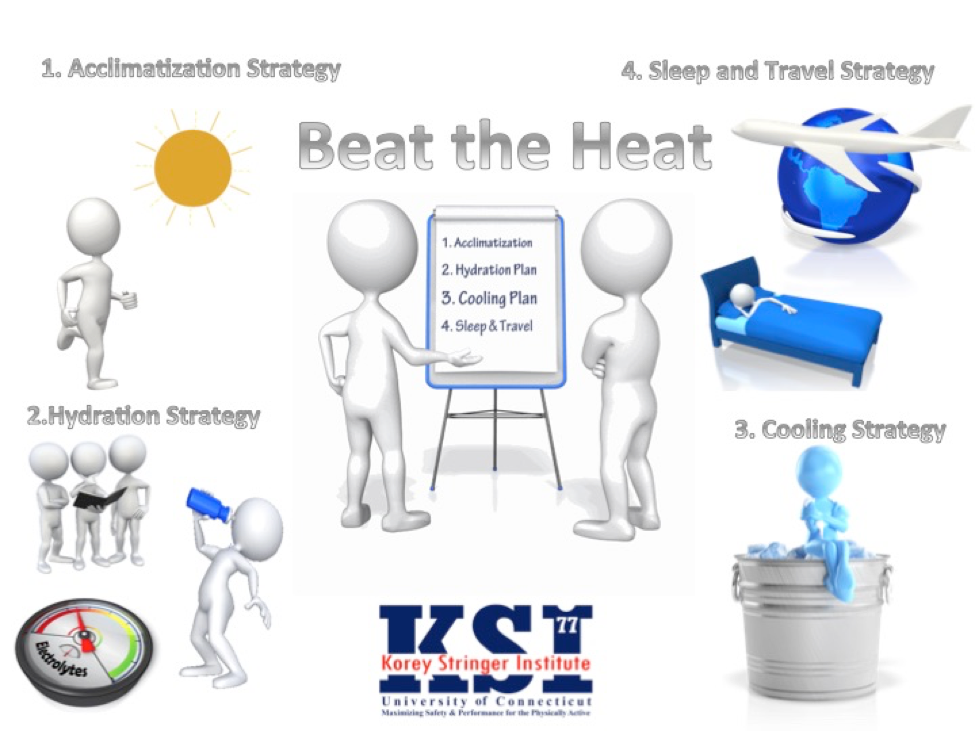By Ryan Curtis, MS, ATC, CSCS, Associate Director of Athlete Performance and Safety
With the Summer Olympics in Rio de Janeiro set to begin in less than a month, athletes are making their final preparations for their opportunity to compete on the world’s biggest stage. For some athletes their performance in the Rio Olympic games may not be solely reliant on the calculated training program and countless hours they’ve dedicated. Instead, their performance could hinge on their ability to prepare for the abnormal heat expected in Rio. With average August temperatures in Rio ranging from the mid 60’s to mid 70’s, temperatures have been forecasted to be in the mid 80’s throughout the games. This potential obstacle outdoor athletes in the Rio might face presents a great opportunity to review key essentials and strategies to optimizing performance in the heat.

- Acclimatization Strategy
- Heat acclimatization is a process in which the body undergoes adaptations to better handle exercise in warm environments
- A minimum of 10-14 days should be used to properly adapt to heat stress, however 2-3 months may be required for optimal performance benefits
- Repetitively exercising in the heat improves cardiovascular efficiency and therefore performance through expansion of blood plasma volume, which leads to increased stroke volume and decreased heart rate.
- Heat acclimatization improves sweat rate and sweat sensitivity so that evaporative heat loss is enhanced and internal core temperatures remain cooler.
- Athletes competing in high ambient temperatures should ensure repeated bouts of training in the heat for biological adaptation that lower physical strain and improve performance
- Exercise in the heat should be at least 60 minutes per day to induce physiological adaptations.
- If possible, train in the same environment as the competition or plan to train at or near the venue for several weeks prior to competition.
- Hydration Strategy
- Exercising in hot environments increases evaporative heat loss (via sweating) and can lead to progressive dehydration (i.e. reduced plasma volume) and increased rates of heat storage if fluids are not adequately replaced.
- Athletes exercising in hot environments often lose 1-1.5 liters of sweat per hour, however some individuals sweat rates can exceed 2.5 liters/hour.
- Athletes should develop individualized hydration strategies based on their sweat rate in a hot environment as drinking to thirst often results in body water deficits which can exceed 2-3% body mass. 2-3% body mass deficits have been associated with decreased performance.
- Athletes training and competing in a warm-hot environment have higher sodium (i.e. salt) losses and therefore requires more sodium than athletes competing in a cooler environment or the general population.
- Post-training hydration routine should include fluid, sodium, carbohydrates and protein.
- Cooling Strategy
- Athletes should develop an appropriate cooling strategy applying external cooling methods (i.e. ice towels, ice bath, or cooling garments) and internal cooling methods (i.e. cold fluid ingestion) specific to their sport, event and individual needs.
- Skin cooling can reduce cardiovascular strain, while whole body cooling can reduce organ and muscle tissue temperature.
- Athletes can cool prior exercise to decrease body temperature and heart rate, during exercise to decrease rate of temperature rise, and after exercise to decrease muscle damage and reduce metabolic response to exercise.
- Sleep and Travel Strategy
- Sleep deprivation can impede thermoregulation in hot environment by decreasing evaporative heat loss mechanisms (i.e. sweat rate and sensitivity).
- Travel, especially across several time zones, can disrupt the body’s natural sleep and wake cycle (i.e. circadian rhythm disruption). Rapid adjustment of the body’s biological rhythms is necessary for ensuring sleep quantity and quality is gained and maximal performance is not lost.
- Plan for 1 day of sleep recovery for every time zone crossed. For example, two weeks of adjustment time would be optimal for travel across the 14 time zones between NY, USA and Sydney, Australia.
- Practice good sleep hygiene habits such as reducing alcohol and caffeine prior to bed, prioritize a 20-30 minute wind down time, maintain a consistent sleep schedule, and power down technology one hour prior to bed.
References:
- Racinais S, Alonso JM, Coutts AJ, Flouris AD, Girard O, González-Alonso J, et al. Consensus recommendations on training and competing in the heat. Br J Sports Med. 2015
- Pryor RR, Casa DJ, Adams WM, Belval LN, DeMartini JK, Huggins RA, et al. Maximizing Athletic Performance in the Heat: Strength and Conditioning Journal. 2013 Dec;35(6):24–33.